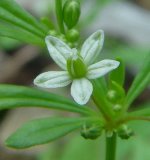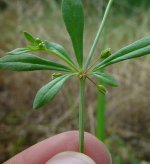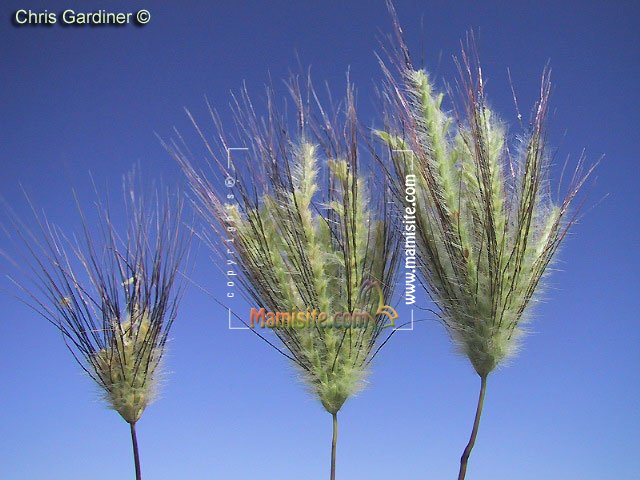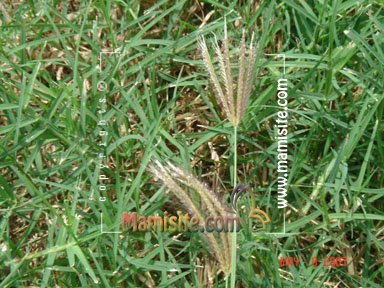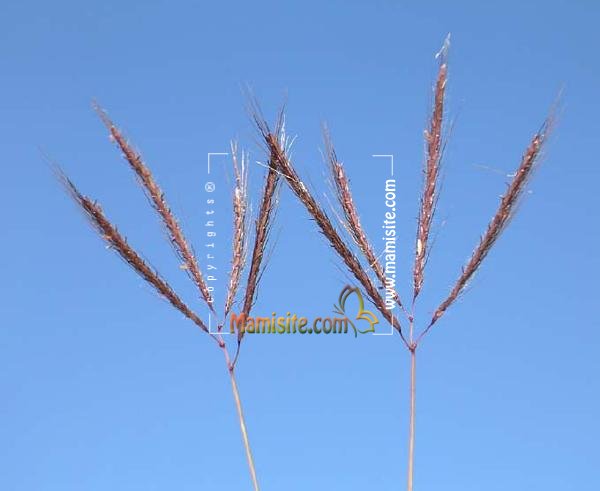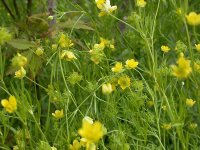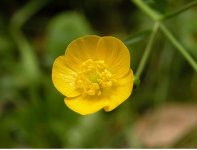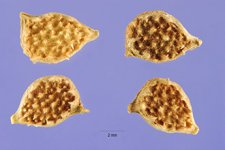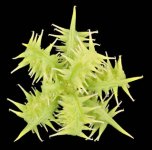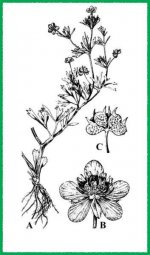You are using an out of date browser. It may not display this or other websites correctly.
You should upgrade or use an alternative browser.
You should upgrade or use an alternative browser.
مسابقه علمی *** کی این علف هرز را می شناسه ؟
- شروع کننده موضوع **آگاهدخت**
- تاریخ شروع
بفرمائید گلاب خانم...من بگم؟ من من....
بله، علف قالی (Mollugo verticillata) هم بهش میگن...مرسي
فكركنم علف فرشي باشه...درسته؟
(Carpet weed)
Mollugo verticillata
Family: Molluginaceae
Mollugo verticillata
Family: Molluginaceae
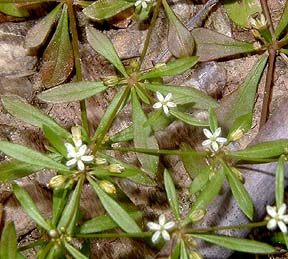
[*=left]Grows prostrate along the ground.
[*=left]Light green leaves that grow in whorls.
[*=left]Whorls have five to eight leaves that are widest in the middle and narrowest at the base and ends.
[*=left]Small white flower with five petals.
[*=left]Long slender stems.
Weed Identification
Carpetweed is a summer annual weed that grows prostrate along the ground. It is sometimes confused with other lawn weeds, such as Carolina Geranium. Once the seeds have germinated it can grow and spread quickly. However, it doesn’t like competition from turfgrass, so it is most commonly seen in dirt patches or in thin grass. It forms long, smooth stems that branch out in all directions.
The leaves of carpetweed grow in whorls along the stem. This is one of the unique qualities of this weed. Each whorl is set a distance from the next whorl on the stem so that the leaves barely touch each other.
Carpetweed produces small, white flowers with five petals. Each whorl will produce two to five flowers that grow from the joint between the leaves and stem.
Carpetweed will climb if growing next to a fense, but will grow prostrate in open ground.
Cultural practices
The prostrate growth habit prefers sparse areas where lawn grass is thin. These thin grassy areas also allow the seeds to receive enough sunlight to quickly germinate as soon as the soil reaches the proper temperatures. The best way to keep carpetweed and other lawn weeds under control is to have a thick, vigorously growing lawn. This will keep most lawn weeds out and cut down on the amount of herbicides used. Established weeds can be pulled up by hand.
Herbicide use
One way to control carpetweed is to use preemergent herbicides. Preemergent herbicides work by blocking seeds from germinating, but will not affect growing lawn weeds. Many preemergents are available to homeowners. Oryzalin, pendimethalin, or benefin are examples of available products.
Once the weed has established you will need to use a post- emergent herbicide. Products with three or four active ingredients are best for most lawn weeds. Dicamba plus 2,4-D should be two of the active ingredients in the formulation.
Carpetweed is a summer annual weed that grows prostrate along the ground. It is sometimes confused with other lawn weeds, such as Carolina Geranium. Once the seeds have germinated it can grow and spread quickly. However, it doesn’t like competition from turfgrass, so it is most commonly seen in dirt patches or in thin grass. It forms long, smooth stems that branch out in all directions.
The leaves of carpetweed grow in whorls along the stem. This is one of the unique qualities of this weed. Each whorl is set a distance from the next whorl on the stem so that the leaves barely touch each other.
Carpetweed produces small, white flowers with five petals. Each whorl will produce two to five flowers that grow from the joint between the leaves and stem.
Carpetweed will climb if growing next to a fense, but will grow prostrate in open ground.
Cultural practices
The prostrate growth habit prefers sparse areas where lawn grass is thin. These thin grassy areas also allow the seeds to receive enough sunlight to quickly germinate as soon as the soil reaches the proper temperatures. The best way to keep carpetweed and other lawn weeds under control is to have a thick, vigorously growing lawn. This will keep most lawn weeds out and cut down on the amount of herbicides used. Established weeds can be pulled up by hand.
Herbicide use
One way to control carpetweed is to use preemergent herbicides. Preemergent herbicides work by blocking seeds from germinating, but will not affect growing lawn weeds. Many preemergents are available to homeowners. Oryzalin, pendimethalin, or benefin are examples of available products.
Once the weed has established you will need to use a post- emergent herbicide. Products with three or four active ingredients are best for most lawn weeds. Dicamba plus 2,4-D should be two of the active ingredients in the formulation.
سلام به همگی
ممنون خانم مهندس گلاب خانم ،جوابتون کاملا درست بود لطفا سوال بعد رو بفرمایید
استاد سپاس از توضیحان کاملتون
ممنون خانم مهندس گلاب خانم ،جوابتون کاملا درست بود لطفا سوال بعد رو بفرمایید
استاد سپاس از توضیحان کاملتون
گلابتون
مدیر بازنشسته
سلام به همگی
ممنون خانم مهندس گلاب خانم ،جوابتون کاملا درست بود لطفا سوال بعد رو بفرمایید
استاد سپاس از توضیحان کاملتون
سلام مهندس عددي جان
ممنونم عزيز...حالا كو تا مهندس شدن من...همون بگيد گلاب يا سايه كافيه....

چشم..
فکر میکنم Chloris virgata باشه...
سلام به همگی
Dichanthium ؟؟؟
Dichanthium ؟؟؟
گلابتون
مدیر بازنشسته
سلام به همگی
Dichanthium ؟؟؟
آفرين مهندس عددي جان...گونه اش رو هم ميفرماييد؟ يا به همين مقدار بسنده كنيم؟

آفرين مهندس عددي جان...گونه اش رو هم ميفرماييد؟ يا به همين مقدار بسنده كنيم؟
ممنون
Dichanthium annulatum
| Scientific name | � |
| Dichanthium annulatum (Forssk.) Stapf Subordinate taxon : Dichanthium annulatum (Forssk.) Stapf var. papillosum (Hochst. ex A. Rich.) de Wet & J.R. Harlan | � |
| Synonyms | � |
| Andropogon annulatus Forssk. Andropogon papillosus Hochst. ex A. Rich. Dichanthium nodosum Willemet Dichanthium papillosum (Hochst. ex A. Rich.) Stapf | � |
| Family/tribe | � |
| Family: Poaceae (alt. Gramineae) subfamily: Panicoideae tribe: Andropogoneae . | � |
| Common names | � |
| bluestem, diaz bluestem, hindi grass, sheda grass, ringed dichanthium, (English); lindi (Philippines); marvel grass, karad, jargu grass, delhi grass (India); vuda blue grass, kleberg blue-stem (USA); pitilla (Cuba); climacuna (Colombia); song tha'o to (Vietnam); ya hindi, ya waen (Thailand); two-flowered golden-beard (Hong Kong). | � |
| Morphological description | � |
| Perennialtussock, sometimes stoloniferous, with culms geniculately ascending, foliage to 80 cm and fertile tillers to about 1 m (rarely 1.8 m); pronounced annulus of radiating, 3-5 mm long white hairs on the nodes; leaf blade linear, to about 30 cm long and 2-7 mm wide, margins sparsely pubescent and scaberulous. Inflorescence a sub-digitatepanicle, comprising 2-9 (-15) pale green or purplish racemes, each 3-7 cm long; geniculate, twisted awn 8-25 mm long arising from the upper lemma of the sessilespikelet. Caryopsisoblong to obovate, dorsally compressed, ca. 2 mm long (1.9 million/kg), although seed weight (sessile + pedicellate spikelet ) about 500,000/kg. Surface rooted, >90% of roots in top 1 m soil. Distinguished from D. caricosum in having nodal annulus , and from D. aristatum in lacking the short, dense pubescence on the peduncle immediately below the lowest raceme . | � |
| Distribution | � |
| Native to: Africa: Kenya, Tanzania, Uganda, Ethiopia, Somalia, Algeria, Egypt, Libya, Morocco, Tunisia, Botswana, Namibia, South Africa, Mali, Senegal, Cape Verde. Asia: Afghanistan, Iran, Iraq, Israel, Jordan, Turkey (south), Bahrain, Saudi Arabia, Indochina, southern China, Myanmar, Thailand, Indonesia, Malaysia, India, Nepal, Pakistan. Other: Papua New Guinea. Naturalised in: Northern Australia and the Americas. Found in situations ranging from dry to moist subtropics and tropics growing in pasture land, roadsides, fallow fields, weedy lawns, sand dunes and open wasteland. | � |
| Uses/applications | � |
| Perennialpasture for grazing or cut-and-carry. Suitable for silage and hay if cut before flowering. Shows promise for re-seeding degraded grasslands and for rough lawns. | � |
| Ecology | � |
| Soil requirements | � |
| Adapted to most textures of soil from coralline sands to heavy black clays (cotton soils). Not fertility demanding, but often found on fertile soils. Prefers neutral to alkaline conditions, occasionally down to pH 5.5. Tolerates poor drainage, but not permanently waterlogged situations. Tolerant of salinity. | � |
| Moisture | Top |
| Mostly in moderately dry to moist areas with annual summer rainfall from 700-1,400 mm, but to as low as 300 mm and as high as 2,600 mm, sometimes with a 6-8 month dry season. | � |
| Temperature | � |
| Good warm season growth. Cut by frosts, but recovers with onset of warm conditions. Occurs naturally at altitudes from sea level to >600 m asl . | � |
| Light | � |
| Not considered shade tolerant. | � |
| Reproductive development | � |
| Flowers throughout the growing season . | � |
| Defoliation | � |
| Stands very heavy grazing, forming an open turf. | � |
| Fire | Top |
| Withstands seasonal burning. | � |
| Agronomy | � |
| Guidelines for the establishment and management of sown pastures. | � |
| Establishment | � |
| Can be established vegetatively from rooted slips, being planted 60 cm apart in staggered rows 60 cm apart. Commercial seed is rarely available. Optimum temperature for germination is 32°C, although germination can be achieved between 15 and 40°C. | � |
| Fertiliser | � |
| Not normally fertilised but responds to low to moderate levels of nitrogen. | � |
| Compatibility (with other species) | � |
| Competes aggressively once established, often suppressing other species. | � |
| Top | � |
| Grasses: Bothriochloa insculpta, Dichanthium aristatum, D. caricosum. Legumes: Desmanthus spp., Medicago sativa, Stylosanthes hamata, S. seabrana http://www.tropicalforages.info/key/Forages/Media/Html/Dichanthium_annulatum.htm جنس Dichanthium : گیاهانی علفی و چند ساله • پوشه ها نازك و غشایی • گل آذین فاقد چمچه • برگها فاقد تیغه نمو یافته • از این جنس گونه D.annulatum دارای مژه های سفید و بلند در محل زانو ها می باشد . منبع:http://shabnamak.mihanblog.com/post/3815 | � |
papaver glaucum
اگه اشتباه نباشه اسم علمیشو نمیدونم درست باشه یا نه
خیر اشتباهه

caratocephalus falcatusاین چی؟
متاسفانه خیر ،بازم اشتباه بود

شایدم اینه؟
آلاله (Ranunculus repens)
نه همینه درسته
آفرین جنس درسته ولی گونه این نیست
تلاش شما شایسته ی تقدیری فراوان است
آفرین جنس درسته ولی گونه این نیست
تلاش شما شایسته ی تقدیری فراوان است
متشکرم.......شما لطف دارید.
آلاله صحرایی :نام علمی : Ranunculus arvensisتیره : Ranunculaceae
گیاهی یکساله از تیره آلاله است که به وسیله بذرتکثیر می شود. خاک های لیمونی را ترجیح می دهد و در مناطق مرطوب به فراوانی می روید. گل های آن دارای پنج گلبرگ اند. دارای 10 تا 13 پرچم و 4 تا 8 میوه دارد که متشکل از چند کارپل با دندانه های خاری هستند که پس از رسیدن جدا می شوند. گیاهی سمی است و در مزارع شتوی، صیفی و زمین های بایر و جوی های آب می روید.
گیاهی یکساله از تیره آلاله است که به وسیله بذرتکثیر می شود. خاک های لیمونی را ترجیح می دهد و در مناطق مرطوب به فراوانی می روید. گل های آن دارای پنج گلبرگ اند. دارای 10 تا 13 پرچم و 4 تا 8 میوه دارد که متشکل از چند کارپل با دندانه های خاری هستند که پس از رسیدن جدا می شوند. گیاهی سمی است و در مزارع شتوی، صیفی و زمین های بایر و جوی های آب می روید.
آلاله صحرایی :نام علمی : Ranunculus arvensisتیره : Ranunculaceae
گیاهی یکساله از تیره آلاله است که به وسیله بذرتکثیر می شود. خاک های لیمونی را ترجیح می دهد و در مناطق مرطوب به فراوانی می روید. گل های آن دارای پنج گلبرگ اند. دارای 10 تا 13 پرچم و 4 تا 8 میوه دارد که متشکل از چند کارپل با دندانه های خاری هستند که پس از رسیدن جدا می شوند. گیاهی سمی است و در مزارع شتوی، صیفی و زمین های بایر و جوی های آب می روید.
آفرین عالی بود خودشه



لطفا سوال بعدی...............

